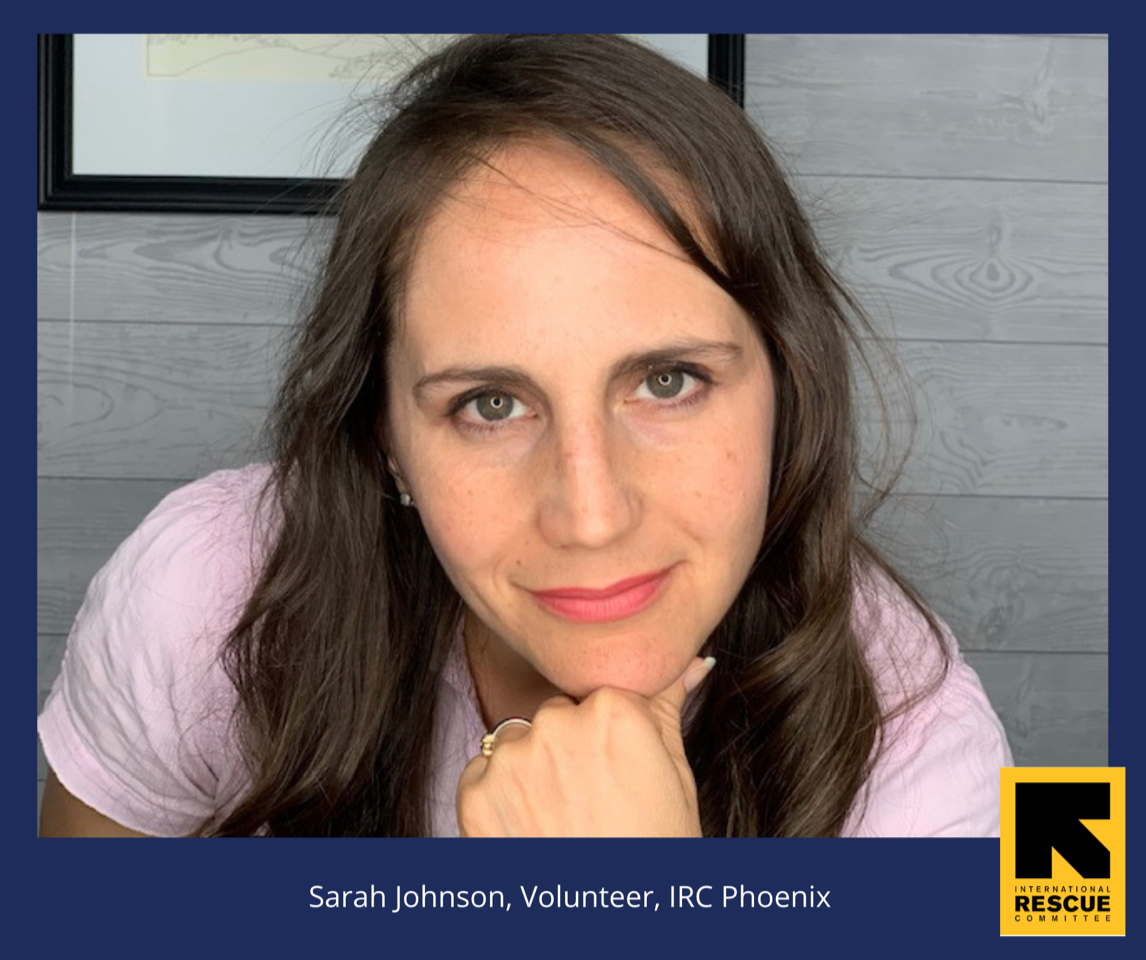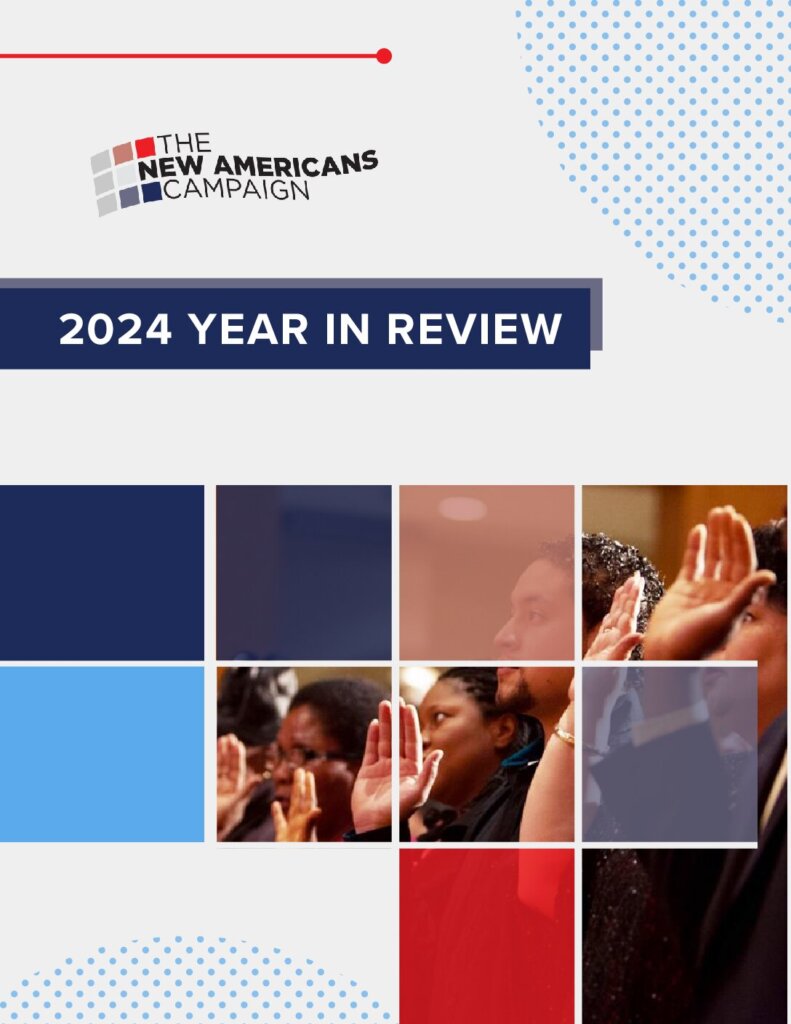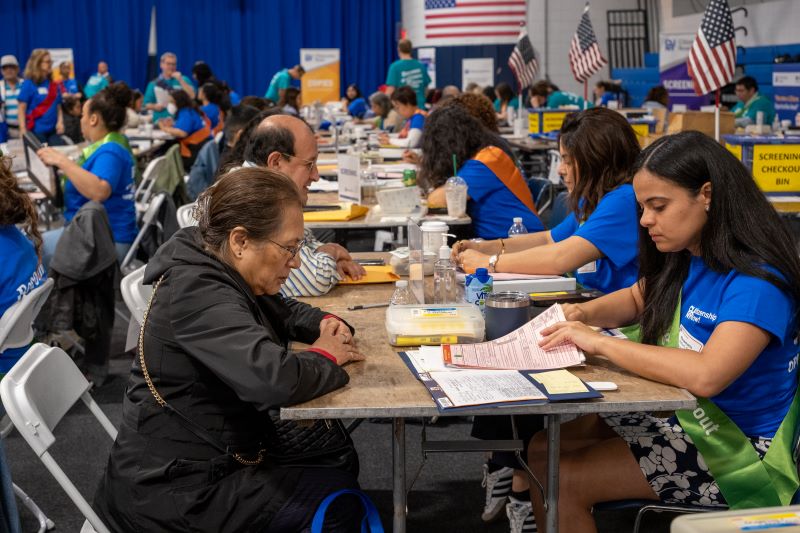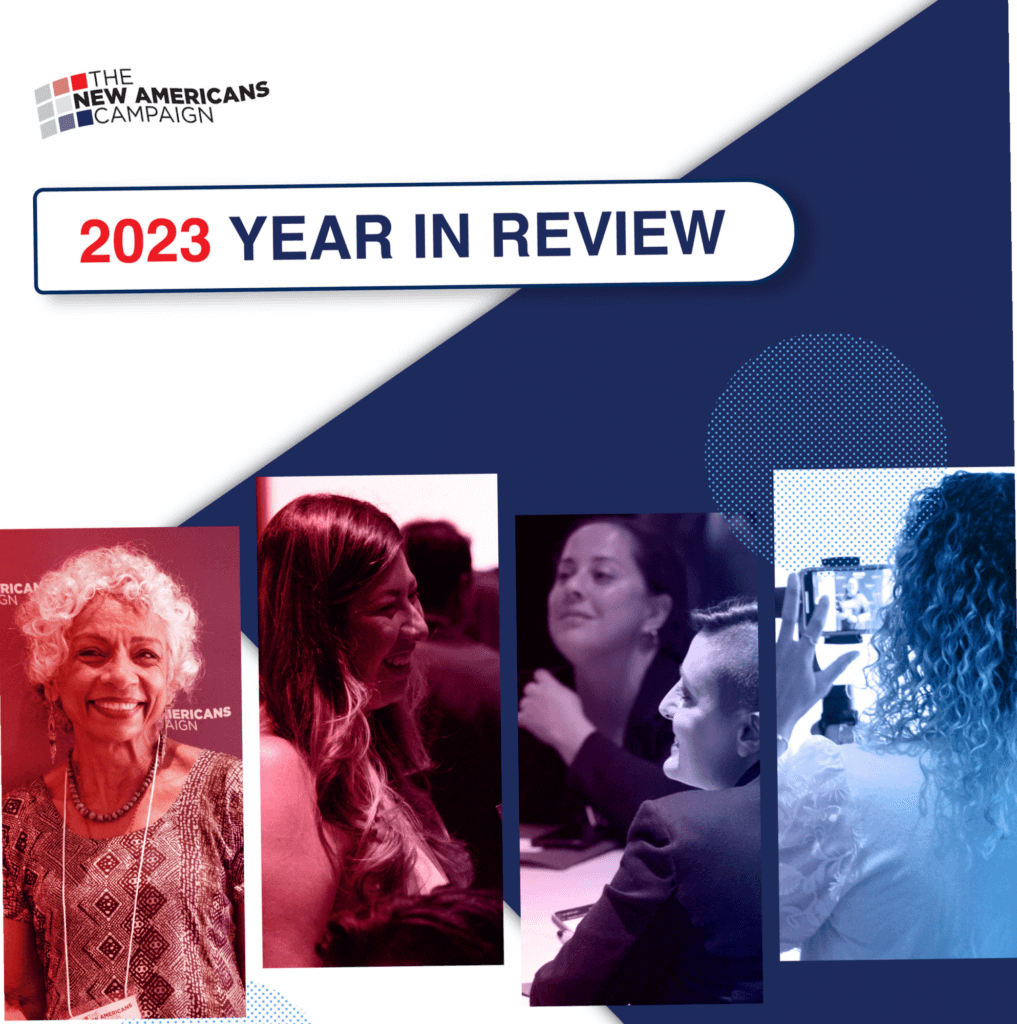IRC Volunteer Sarah Johnson: Raising Funds in Phoenix with a New Americans Campaign EFFORTS Grant

Explore More
The New Americans Campaign, with support from the Carnegie Corporation of New York, set up a fund in 2018 to help partners develop and experiment with new fundraising strategies for their naturalization programs. The goal of the Experimentation Fund for Optimizing Revenue-raising Techniques & Streams (EFFORTS) was to encourage partners to find new revenue streams, develop partnerships, and create innovative fundraising projects that are measurable and replicable. More than 25 grants were given to partners in 11 states. Participants in the EFFORTS fund developed several exciting strategies that are shared in a new best practices toolkit. The New Americans Campaign also reached out to Sarah Johnson, an EFFORTS fund participant, to share the insights that she gleaned while raising money for the International Rescue Committee (IRC) in Phoenix.
Johnson is a Phoenix-based businesswoman with experience
fundraising for non-profits. She is passionate about helping refugees and
immigrants and has been volunteering for the IRC in Phoenix for the past year.
With the help of an EFFORTS grant, and despite the onset of the coronavirus
pandemic this past spring, she ran a successful matching fund campaign. Johnson
set out to raise a total of $8000 to support people applying for U.S.
citizenship, and in the process she developed messaging, partners, and strategies
that we can all learn from.
Q: Tell me about the New Americans Campaign EFFORTS grant
and what it was about the challenge that appealed to you?
Sarah Johnson:
The EFFORTS grant is a way to help organizations like the IRC in Phoenix
with their networking and fundraising. I saw that the EFFORTS fund would match
donations to IRC up to $4,000. I knew that if I could raise $4,000, I would
double our efforts with the grant, and we would really be making $8,000. Then
we wanted to find a target number that people could wrap their minds around.
After we estimated that it takes $140 to help one person apply for citizenship,
we figured out that with a total of $8,000 we would help more than 57 people
apply for citizenship.
Q: What was your strategy for identifying potential
donors?
Sarah Johnson:
I began my research on social media. I used my personal Instagram
account and searched back to 2015 for the hashtag “IRCPhoenix,” looking for
businesses that had used it. Businesses and people often used the hashtag when
they attended events held by the IRC, like the IRC World Fair. That helped me
identify business owners that had positive feelings toward the IRC in Phoenix.
I also went to Facebook and found the people who “liked” IRC in Phoenix. I
found 38 potential donors—not counting the duplicates between both social media
platforms. I don’t have a Twitter account, so I didn’t search on Twitter, but
if I were to do this again, I would also search on both Twitter and LinkedIn.
Q: How did you reach out to potential donors and was
there a way of knowing whether they were previous donors?
Sarah Johnson:
Yes. I took my list and put it into an Excel sheet and shared it with
Nicole Walker, the IRC in Phoenix Development Manager. Nicole went through and
identified previous donors, or individuals she thought would not be able to
donate but might be able to spread the word. I found their phone numbers and
other contact information on Facebook or on their websites. When I first began
this project, I planned to talk to people in person. But soon we were into the
pandemic and the shutdown and no one was doing face-to-face contact at all.
Instead, I started with the phone numbers and I went through and I called all
that I could. If they didn’t answer, I left messages. In addition to the list
of 38 contacts from social media, I went through my personal local business
contacts and called them as well.
When I contacted someone, I first explained the mission of
the IRC, then I said, “We’re raising money to help people apply for citizenship
and there’s a challenge grant that we want to match.” Usually people are
interested right away and are ready to donate with the phone call, or they are
not interested. I always “invite,” because you don’t get a donation if you
don’t invite one. I would say, “Would you like to donate?” I also asked if they
would like more information. Because some people like to have something
written, we created an email that I personalized for each recipient.
I think it helped that I am a business owner—connections are
really important, and I know time is of the essence. Because of the pandemic
and because people were sheltering in place at that moment it was nice for us
to connect. But you don’t want to take a lot of their time doing this, and they
want it to be quick and easy.
Q: How do you make it quick and easy?
Sarah Johnson: I know the way that a lot of business
owners look at email—they just skim it. I purposely put bullet points at the
top. Then there’s more information for people who want more details down at the
bottom.
Q: What social media or technology worked best for you?
Sarah Johnson: I used the things that I’m familiar
with—phone calling and email. I am also
familiar with Instagram and Facebook. I knew how to post on Instagram and just
click the switch to post it on Facebook as well. I also used text messaging and
I was surprised at how many people I called who would reply with texts—even
business owners that I didn’t know. When I called, I left a message saying,
“Hi, I’m a volunteer with the IRC in Phoenix, I wanted to talk to you about
what we’re doing now with local businesses.” And I would end by saying you can
call or text me at this number. So many of them texted me back. I think people
want speed.
It’s sad that we couldn’t do more face-to-face contacting;
it’s always harder for someone to say no in person. It’s still better to talk
on the phone with someone, person to person, than to email or even to text
because people are more likely to say yes. I did have quite a few people who
said, “I would love to donate but, because of the pandemic, our business has
shut down; maybe at a future time.” But making it personal always is
beneficial.
Q: How did you develop the messaging and how important is
it to the campaign?
Sarah Johnson: The messaging was very important. We
needed a message that worked for email, as well as one for our fundraising
website. I collaborated with the IRC in Phoenix to get it right. I come from a
business perspective, and I would ask: what’s in it for me and my business, and
what’s happening in the world right now? The IRC staff gave me a lot of input
and we tweaked the language together. Nicole Walker suggested that we give
business owners a benefit for their donation by offering to promote them on
Facebook where we have more than 5,000 followers.
One of the interesting things that I learned while
researching the IRC was that most of IRC’s clients—refugees, asylum seekers,
and other immigrants—are small business owners. Since I was approaching
business owners for donations, I thought that it might help them to identify
with the IRC clients. That became one of our main bullet points. I wrote: “Many of the IRC’s clients in Phoenix are
small business owners. When your business donates to this campaign, you gain
exposure, promotion, and tax benefits. Support New Americans on the path to
citizenship!”
We also explained that $140 helps one person apply for
citizenship, because we thought that is an amount that many people can donate.
Some people said, since you have those matching funds from the EFFORTS grant, I
can donate $70 and still help one person apply for citizenship. I felt like those specific points were our
best messages.
Q: Tell us more about the platform you used for your
fundraising website.
Sarah Johnson: The GoFundMe site was very user
friendly. I was able to use the IRC logo and the New Americans campaign logo,
which fit perfectly at the top of their banner. I wish they had allowed more
pictures; we could only use two or three.
We took our messaging email and adapted that language. They
also list the donors and their donation amount, unless they want to be
anonymous. Donors could also include a message. This was really neat because
some people dedicated their messages. For example, “This is for all of the
immigrants,” or “This is for my mom who came here from Thailand,” or “This is for my ancestors.” I really liked
that.
Whenever someone donated, I received an email saying,
“Congratulations, this individual has donated to your fundraiser, click here to
thank them. Then you can click and have a thank you email sent to them. I don’t
think I took advantage of that enough. I sent a personalized paper thank you
note to each business. That was important to me on a business-to-business level.
I wanted to let them know that this meant a lot to me personally and I wanted
them to get that letter in the mail that says you did something great.
Q: Any important tips on how to roll out the
campaign?
Sarah Johnson: The timing is crucial with a
crowdsourcing fundraising campaign. People advised me to target a specific day
to start the campaign. It’s very important because you don’t want to launch the
campaign and have people see that no one’s donated. They might question the fundraiser’s
legitimacy or think that it’s a flop. I told the businesses that I wanted to
give them the best benefit and exposure, so we are all going to donate on May
7. Then everyone donating on that day will see the participating businesses,
see movement, and see that we were having some success.
On May 6, the day before, I sent an email reminder with the
link and I asked people to please donate by noon on May 7. The next day, boom,
boom, boom, boom, boom, all these businesses did it. I probably cheered. Woo
hoo! I did kneel down to pray and thank God. For me personally it was really
encouraging. And as a fundraiser we were already over a quarter of the way
toward our goal within 24 hours. I didn’t realize how much pressure I had put
on myself until that moment. I thought, “It’s working!” It was very cool.
Q: How long did the fundraiser run overall?
Sarah Johnson: We had a calendar window of about 10
days. We decided that it would wrap up on May 16, “Do a Good Deed for your Neighbor Day.” We
didn’t actually reach our fundraising goal by that time. But I opened it up to
friends and family, and the general public, and I kept on promoting it. I knew
from experience with previous fundraisers that even when you have a deadline,
people always want to go past it and that’s okay. I continued to thank the
business donors and eventually not only reached but exceeded our goal. The most
important lesson is— don’t give up.
Q: The project reaped more than financial rewards. Tell
us about other positive results.
Sarah Johnson: One of our biggest donations came from
a local immigration attorney. She was great to work with and donated right
away. Afterwards, someone at the IRC in Phoenix noticed that she does
immigration law and wondered whether she would be willing to do some pro bono
work. I didn’t know her personally, but she was great to work with, so I called
her again to explore the possibility. Eventually, she connected with one of the
IRC staff and they worked out an arrangement for her to help.
Q: You clearly enjoy the fundraising process.
Sarah Johnson: I know. I’m a little weird. I just
enjoy it. My approach is positive because I think about how I’m going to help someone.
I focus on the fact that I’m helping our refugees and our clients. As a
business owner, I know you get tax benefits for donating to nonprofits. I am
also helping that business gain exposure. I am always thinking, “Hey, I can do
something really cool for you. Do you want to do something cool with me?”
I try not to focus on the “Nos.” Lots of people said no to
me and that’s okay. You just have to remember that you might talk to 10 or 20
people and maybe you only get three people to say yes. But three people said
yes—that’s what you focus on.



